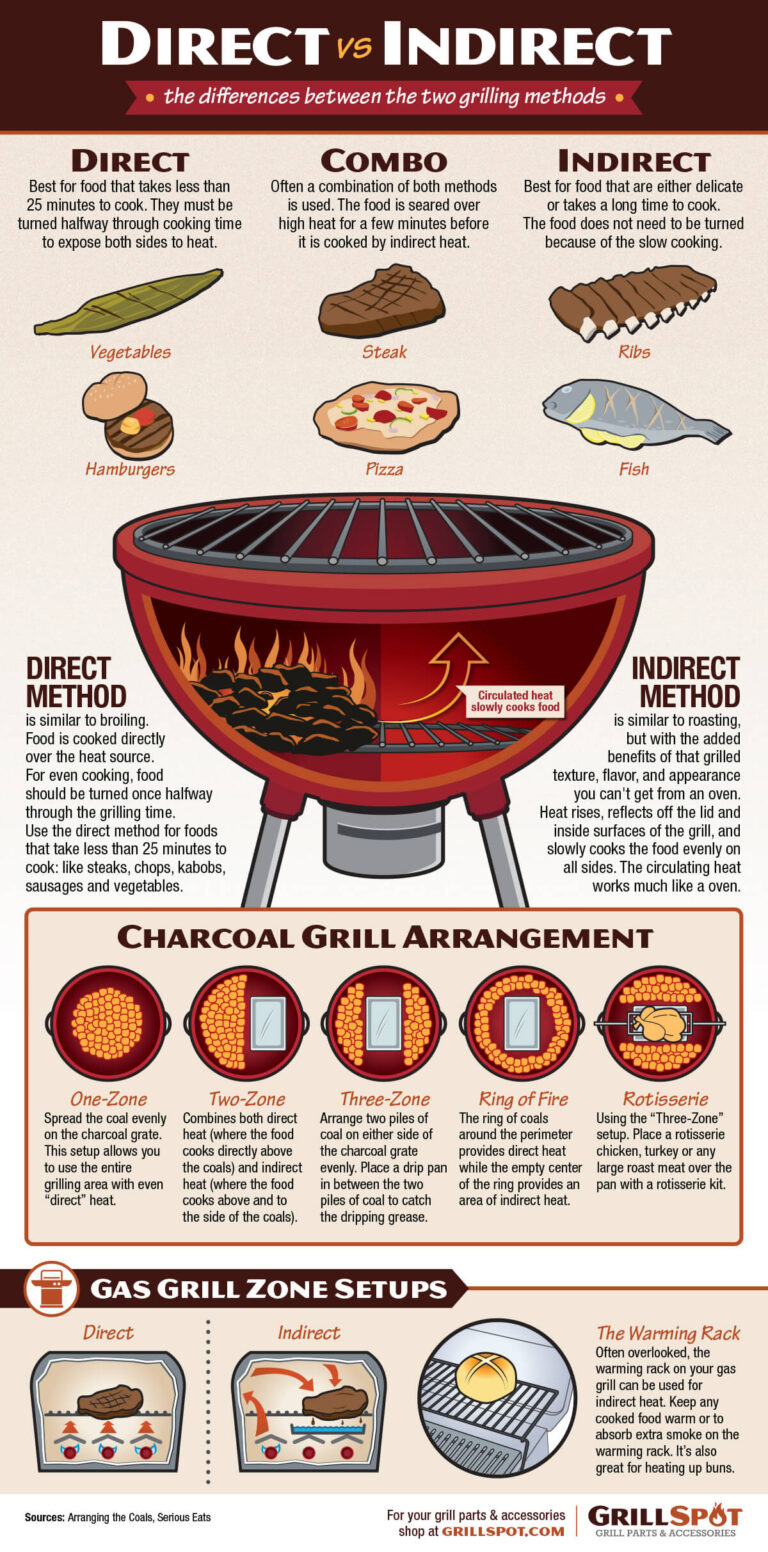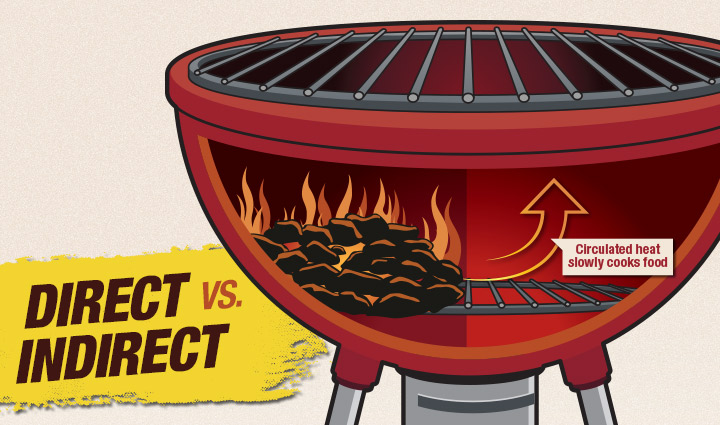It’s important to know which grilling method to use for your next barbecue meal: direct, indirect, or a combination of both. It doesn’t matter what kind of grill you have—you can use any grilling method on both gas and charcoal grills.
On a charcoal grill, you can deliver direct or indirect heat to your food by arranging your coals in different patterns. On a gas grill, you can create direct and indirect heat zones with ease simply by selectively turning on your gas grill’s burners.
Understanding the difference between direct and indirect grilling will help you create perfectly cooked grilled meals, whether you’re cooking low and slow or hot and fast. Before we show you how to set up your charcoal or gas grill for each grilling method, let’s take a look at what the difference is between direct and indirect grilling.
What’s the Difference Between Direct and Indirect Heat Grilling Methods?
Direct or indirect heat are the two main grilling methods you can use to deliver heat to your food on your grill. The key difference between the two methods is how they deliver the heat to your food.
Direct heat
Direct heat grilling is similar to broiling, where you cook the food fast and hot directly over the heat source. Since the food is directly exposed to the fire, the direct grilling method can help you create those perfect grill marks. Remember to turn your food once halfway through the grilling time so your food gets cooked evenly.
When to use direct heat: Use the direct heat grilling method for food that takes less than 25 minutes to cook. Your food must be turned halfway through its cooking time to expose both sides to heat. Direct heat grilling is perfect for food such as hamburgers, vegetables and shrimp.
Indirect heat
Indirect heat grilling is similar to roasting where you cook low and slow, but with the added benefit of that delicious texture, flavor, and appearance that you can only achieve on a grill.
When the heat from your grill rises, it reflects off the interior of the lid and the grill’s surfaces to slowly cook your food evenly on all sides. The circulated heat works like an oven, and your food does not need to be turned because of the slow cooking process.
Since indirect heat is created by reflected heat, this method only works when your grill is covered. Try to avoid peeking at your meal when you are using the indirect grilling method since heat will escape every time you lift the lid and your meal will take longer to cook.
When to use indirect heat: Use indirect grilling method for food that’s either delicate or takes a long time to cook. Indirect heat grilling is perfect for food such as ribs, whole chickens, and fish, as well as traditional “low and slow” meals like brisket and other tough cuts of meat.
Combination heat
Combination heat grilling uses a mix of both direct and indirect methods—the food is first seared over direct high heat for a few minutes, then cooked to finish over indirect heat.
When to use combination heat: Use the combination grilling method for food that tastes better when it has a crispy, caramelized exterior and a tender interior, such as steak and pizza.
How to Set up a Charcoal Grill for Direct and Indirect Grilling
When you’re using a charcoal grill, the secret to delivering direct or indirect heat is to properly arrange your coals properly.
Before you begin grilling on a charcoal kettle grill, prepare and light the charcoal in a chimney starter and let it sit for 20 minutes. Once the coals are hot enough, you can arrange them in different setups. Don’t forget to check to see if there is enough charcoal every hour to keep the fire burning and to maintain an even cooking temperature.
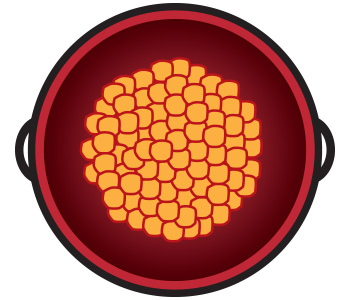
Direct Heat Grilling
Spread the coals evenly on your charcoal grill’s charcoal grate. This arrangement allows you to use the entire grilling area for direct heat grilling.
Perfect for: Any thin cuts of meat.
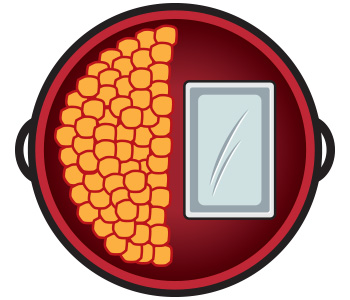
Two-Zone Heating
The two-zone heating method is the most commonly used and most versatile charcoal arrangement setup. With this setup, the hot charcoal covers half of the charcoal grill while leaving the other half empty. This setup leaves you with half of the grill using direct heat for searing and the other half for slowly cooking meals over indirect heat.
Perfect for: Steaks, pork chops, boneless chicken, seafood, veggies and desserts.
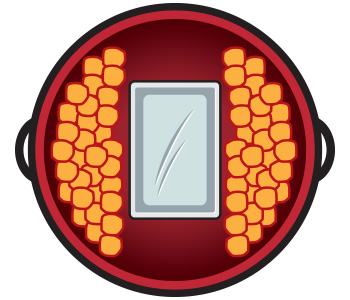
Three-Zone
With this method, the coals are spread on either side of the grill, leaving the middle of your grill empty to use for indirect heat.
For a quick and easy three-zone setup, you can purchase a charcoal briquet holder.
Perfect for: Larger roasts and thicker cuts of meat.
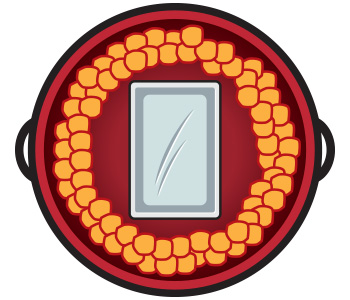
Ring Of Fire
Place your coals in a circle around the edges of your charcoal grate. Arranging your coals around the perimeter will provide direct heat while the center of the ring provides an area of indirect heat.
This setup is typically used for “smoking” your meat. To add flavor to your food, add in some hardwood chips with your coals. Always soak the wood chips for 30 to 60 minutes before adding them to your grill, otherwise they’ll burn too quickly.
The biggest disadvantage to this charcoal arrangement setup is that it’s very time-consuming to position the coals in a circle formation.
Perfect for: Adding a smoky taste.
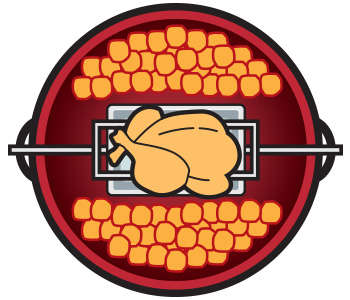
Rotisserie
Set up the coals with the three-zone setup. Then set up your chicken, turkey or larger roasting meat using a rotisserie kit.
Perfect for: Rotisserie chicken or turkey, and larger roasts.
How to Set up a Gas Grill for Direct and Indirect Grilling
Most people think that zone cooking can only be done on a charcoal kettle grill, but you can easily set up heat zones on your gas grill as well. Setting up your gas grill for direct and/or indirect grilling is actually simpler than setting up a charcoal grill.
GRILL SPOT TIP: It’s always a good idea to preheat the entire grill so it burns off any remaining residue from when you grilled last. Preheat your grill to 500°F (260°C), close the lid and turn all burners to “high”. Then, using a bristle grill brush, thoroughly brush your cooking grates until they are free from any build-up.
If you don’t have a bristle grill brush, you can try cleaning your grill’s cooking grates with an onion.
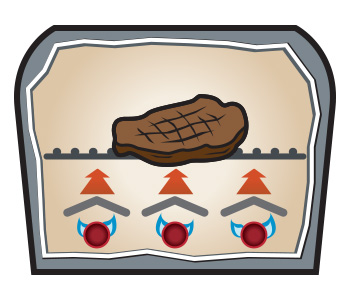
Direct Heat Grilling
Turn the burner “on” using the control panel located right underneath the food you are grilling. Grill your food directly over the hot burner.
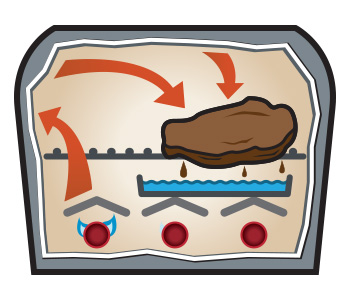
Indirect
Two-Zone — Turn the burner “on” using the control panel that’s furthest from the food you are grilling. Leave the burner that’s right underneath your food set to “off” so the heat from the adjacent burner can reflect off the lid and slowly cook your meal.
Three-Zone — Turn on the two side burners and leave the burner in the middle off.
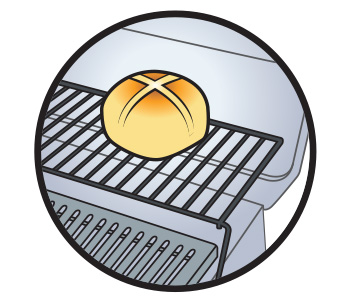
Warming Rack
You can also use your warming rack for indirect heat. The warming rack helps keep any cooked food warm and also allows it to absorb extra smoke. It’s also great for heating up buns!
GRILL SPOT TIP: Place an aluminum drip pan with water right underneath your food when using the indirect grilling method. The aluminum drip pan serves two purposes:
- The water helps keep the food moist during indirect cooking as prolonged cooking can dry out the meat. You can also experiment with beer, wine, or cider mixtures or any marinades to add smoke flavoring to your meat.
- The drip pan also collects all the fat and grease from your meat and prevents it from dripping onto your grill as grease buildup can damage your grill’s parts. It can also help you clean up faster.
Alternative Indirect Grilling Methods
You can also provide indirect heat to your food by using barbecue grilling accessories that create a barrier between your cooking grates and the food, such as a wood grilling plank or a pizza stone.
To use your wood plank or pizza stone, set up your grill with the three-zone set up, then place your food in the middle section (away from the fire).
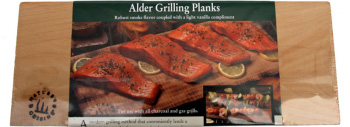
Plank Cooking (Planking)
The plank wood infuses your food with the wood’s natural oils and moisture. Different types of wood will create different flavours. Before putting it on to your grill, submerge the wood plank in a water pan and soak it for at least 30 minutes. Otherwise it will leave a strong burnt taste or may even catch on fire.
Planks are typically used for salmon and wild meats, but they can also be used for other types of food as well.
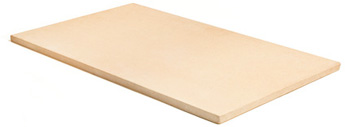
Pizza Stone (Baking Stone)
Pizza stones are typically made out of ceramic or fired-clay. They can withstand high temperatures, and they recreate the conditions of a brick oven on your grill. The stone absorbs the heat from below and transfers it to your food to cook it evenly. The stone also pulls in moisture from your pizza or bread, leaving it with a crackling gourmet-style crust.
Using different grilling methods can add another dimension to your grilling technique. Do you have a favorite recipe that uses a direct or indirect method, or even a combination of both grilling methods? Share it with us in the comments below!Planks are typically used for salmon and wild meats, but they can also be used for other types of food as well.
